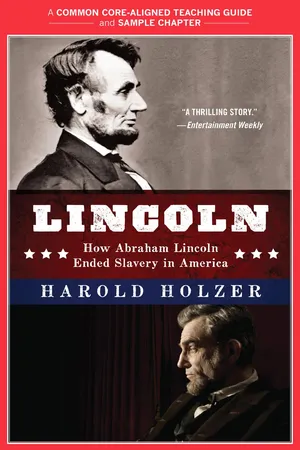![]()
Teacher’s Guide
A NOTE TO TEACHERS
BEFORE YOU READ
• Were you surprised by the way that Spielberg incorporated Lincoln’s most famous speech into his film?
• What statement do you think the director made by having Lincoln’s words spoken back to him rather than spoken by him?
• What is significant about the setting of this scene?
• What is significant about the three characters that recite the Gettysburg Address?
![]()
PROLOGUE: A “KING’S CURE”
1. Based on its root words, what do you think the word “amendment” means? Why are amendments necessary? CCSS.ELA.Literacy.RI.8.5b
2. What was the purpose of the Thirteenth Amendment? CCSS.ELA.Literacy.RI.8.1 CCSS.ELA-Literacy.RH.6-8.2
3. How many times did Lincoln try to get the amendment passed? CCSS.ELA.Literacy.RI.8.1 CCSS.ELA-Literacy.RH.6-8.2
4. Explain the process for passing an amendment to the Constitution. CCSS.ELA.Literacy.RI.8.2 CCSS.ELA-Literacy.RH.6-8.3
5. Why was the Thirteenth Amendment necessary even after the Emancipation Proclamation had been passed? (View chapter four of the film Lincoln). CCSS.ELA.Literacy.RI.8.1 CCSS.ELA-Literacy.RH.6-8.7
6. What do you think Lincoln meant when he called the amendment “a King’s cure for all the evils” (p. 6)? CCSS.ELA.Literacy.RI.8.4 CCSS.ELA-Literacy.RH.6-8.4
7. Why do you think Lincoln added his signature to the Thirteenth Amendment? CCSS.ELA.Literacy.RI.8.1 CCSS.ELA-Literacy.RH.6-8.1
CHAPTER ONE: THE MAKING OF A LIBERATOR
1. What did Lincoln’s father teach him about slavery? As he was growing up, how much interaction did Lincoln have with slaves or free people of color? CCSS.ELA-Literacy.RI.8.3 CCSS.ELA-Literacy.RH.6-8.1
2. On page 10, Holzer writes that Lincoln’s father “moved his family northwest to the state of Indiana, mostly in search of better land and more opportunity, but perhaps to get farther away from slavery as well.” What part of this statement is objective? What part is subjective? CCSS.ELA-Literacy.RI.8.6 CCSS.ELA-Literacy.RH.6-8.8
3. Describe Lincoln’s education. At what point in his life did he begin working? What type of jobs did he have? Why did he start to work? CCSS.ELA-Literacy.RI.8.2 CCSS.ELA-Literacy.RH.6-8.2
4. Why was Lincoln’s stepmother, Sarah, such an important figure in his life? CCSS.ELA-Literacy.RI.8.3 CCSS.ELA-Literacy.RH.6-8.1
5. Why do you think the story of George Washington resonated with Abraham Lincoln? What is your favorite book? Why does it appeal to you? CCSS.ELA-Literacy.RI.8.1 CCSS.ELA-Literacy.RH.6-8.1
6. Describe Lincoln’s first experience witnessing slavery. How did it affect him? (For comparison, view chapter 14 of the film Lincoln.) CCSS.ELA-Literacy.RI. 8.7 CCSS.ELA-Literacy.RH.6-8.7
7. What career did Lincoln decide to pursue? Why was this a good fit for him? CCSS.ELA-Literacy.RI.8.1 CCSS.ELA-Literacy.RH.6-8.1
8. Describe Lincoln’s experience serving in the military. Why did he enlist? CCSS.ELA-Literacy.RI.8.2 CCSS.ELA-Literacy.RH.6-8.2
9. What was the first elected office that Lincoln ran for? What was the outcome of his first campaign? CCSS.ELA-Literacy.RI.8.1 CCSS.ELA-Literacy.RH.6-8.1
10. Describe Lincoln’s experiences with women. What qualities do you think he was looking for in a potential mate? Why did he initially have difficulty finding a wife? CCSS.ELA-Literacy.RI.8.3 CCSS.ELA-Literacy.RH.6-8.2
11. What protest did Lincoln sign during his first term as a legislator? What did he believe about slavery? CCSS.ELA-Literacy.RI.8.1 CCSS.ELA-Literacy.RH.6-8.1
CHAPTER TWO: ROMANCE, LAW, AND POLITICS
1. Describe Mary Ann Todd. How did Lincoln meet her? Who was his rival for her affection? CCSS.ELA-Literacy.RI.8.1 CCSS.ELA-Literacy.RH.6-8.1
2. Explain how the climate and geography of the North and South impacted each region’s dependence on and acceptance of slavery. CCSS.ELA-Literacy.RI.8.3 CCSS.ELA-Literacy.RH.6-8.2
3. What did Mary Ann Todd and Abraham Lincoln have in common? CCSS.ELA-Literacy.RI.8.3 CCSS.ELA-Literacy.RH.6-8.2
4. What did Mary Ann Todd believe about slavery? How did her childhood experiences impact her view of this issue? CCSS.ELA-Literacy.RI.8.2 CCSS.ELA-Literacy.RH.6-8.1
5. What political party did Mary and Lincoln favor? CCSS.ELA-Literacy.RI.8.1 CCSS.ELA-Literacy.RH.6-8.1
6. Find the example of foreshadowing on page 29. CCSS.ELA-Literacy.RI.8.4
CHAPTER THREE: THE LINCOLNS GO TO WASHINGTON
1. What detail suggests that, at this point in his life, Lincoln did not violently object to slavery in the South? CCSS.ELA-Literacy.RI.8.1 CCSS.ELA-Literacy.RH.6-8.1
2. Describe the role that slavery played in Washington. CCSS.ELA-Literacy.RI.8.2 CCSS.ELA-Literacy.RH.6-8.2
3. Why did the end of the Mexican War present an opportunity for proslavery senators and representatives? What bill did David Wilmot introduce as result? Was his bill passed? CCSS.ELA-Literacy.RI.8.3 CCSS.ELA-Literacy.RH.6-8.2
4. What law did Lincoln propose during his first term as a congressman? Did his law pass? CCSS.ELA-Literacy.RI.8.1 CCSS.ELA-Literacy.RH.6-8.1
5. Why did Lincoln leave congress after one term? What personal tragedy did he suffer at the end his first term? CCSS.ELA-Literacy.RI.8...
